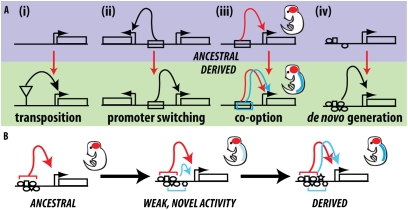Fig. 6.
Evolutionary origins of novel gene expression patterns. (A) Models for the evolution of enhancer elements (as discussed in the main text). (i) Transposition of a functional enhancer into a new location may confer on that locus a novel expression specificity. (ii) An existing enhancer may derive changes in enhancer-promoter specificity that cause it to activate an alternate promoter. (iii) In a co-option event, an existing enhancer may be modified to generate an additional expression feature. (iv) Nonfunctional DNA may accumulate mutations that generate a functional enhancer. (B) Model for the co-option of an existing enhancer to generate a novel activity. An ancestral enhancer (Left) contains TF binding sites that, in the presence of additional sites (Center), drive a weak activity in a novel location. (Right) This embodies the initial step of a co-option event, after which additional mutations that generate binding sites can create a strong, stable, derived pattern of expression.

